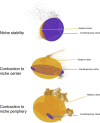Ecological marginalization is widespread and increases extinction risk in mammals
- PMID: 36623195
- PMCID: PMC9934025
- DOI: 10.1073/pnas.2205315120
Ecological marginalization is widespread and increases extinction risk in mammals
Abstract
Human land-use results in widespread range change across taxa. Anthropogenic pressures can result in species' realized niches expanding, shifting, or contracting. Marginalization occurs when contraction constrains species to the geographic or ecological extremes of their historic niche. Using 4,785 terrestrial mammal species, we show that range contraction results in niche space and habitat diversity loss. Additionally, ecological marginalization is a common consequence of range contraction caused by human land use change. Remnant populations become located in the climatic and topographic extremes of their historic niche that are more likely to be at the periphery of their historic niche at greater distances from historic niche centroids. This ecological marginalization is associated with poor performance and increased extinction risk independent of geographic range loss. Range loss and marginalization may create a "double whammy" in vulnerable groups, such as large-bodied species and species with small geographical range size. Our results reveal a hitherto unrecognized conservation threat that is vital to incorporate into conservation assessment and management.
Keywords: dynamics; marginality; performance; range loss; threats.
Conflict of interest statement
The authors declare no competing interest.
Figures



Comment in
-
The ecological and geographic dynamics of extinction: Niche modeling and ecological marginalization.Proc Natl Acad Sci U S A. 2023 Jan 17;120(3):e2220467120. doi: 10.1073/pnas.2220467120. Epub 2023 Jan 12. Proc Natl Acad Sci U S A. 2023. PMID: 36634132 Free PMC article. No abstract available.
References
-
- Ellis E. C., Anthropogenic transformation of the terrestrial biosphere. Philos. Trans. R. Soc. A Math. Phys. Eng. Sci. 369, 1010–1035 (2011). - PubMed
-
- Tilman D., et al. , Future threats to biodiversity and pathways to their prevention. Nature 546, 73–81 (2017). - PubMed
-
- UNEP-WCMC and IUCN, “UNEP-WCMC and IUCN protected planet report 2020” (UNEP-WCMC and IUCN, Cambridge UK, Switzerland, Gland, 2020).
-
- Kuussaari M., et al. , Extinction debt: A challenge for biodiversity conservation. Trends Ecol. Evol. 24, 564–571 (2009). - PubMed
MeSH terms
LinkOut - more resources
Full Text Sources
Other Literature Sources

